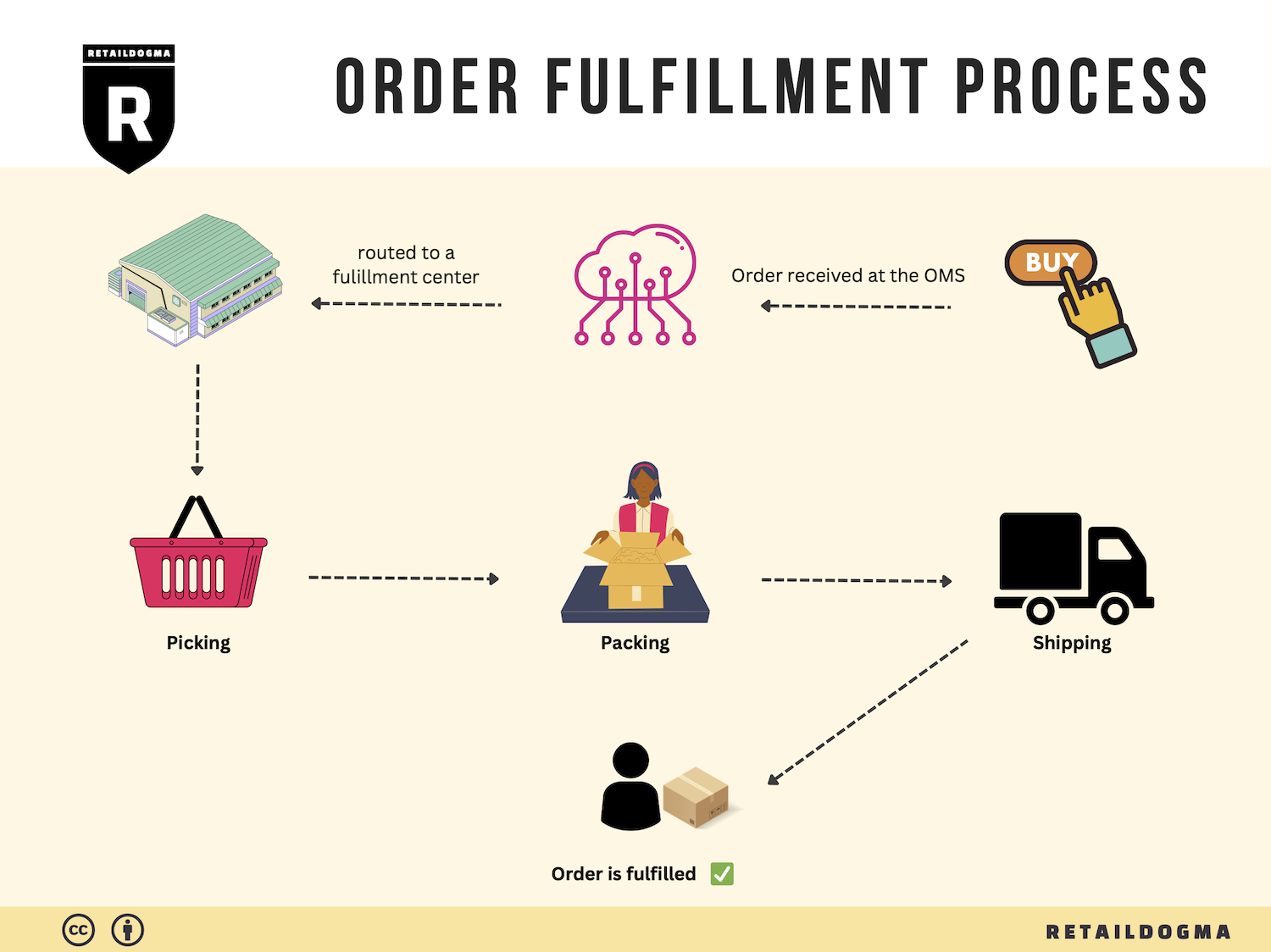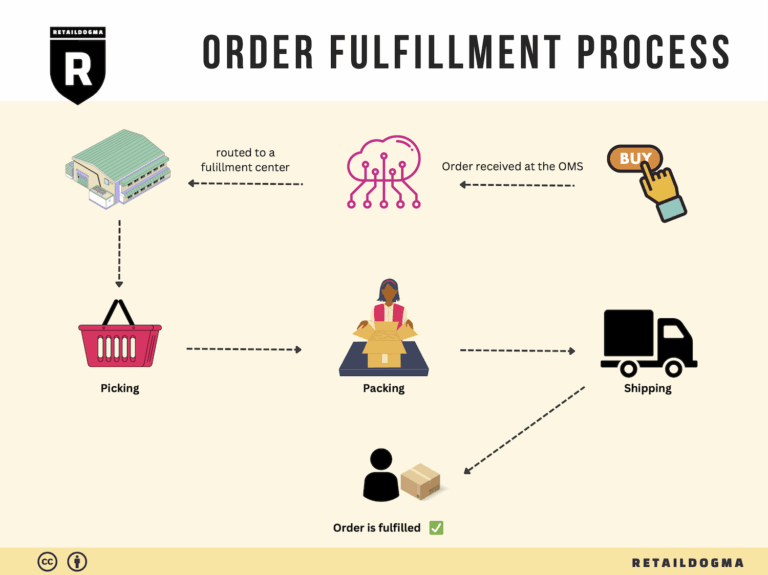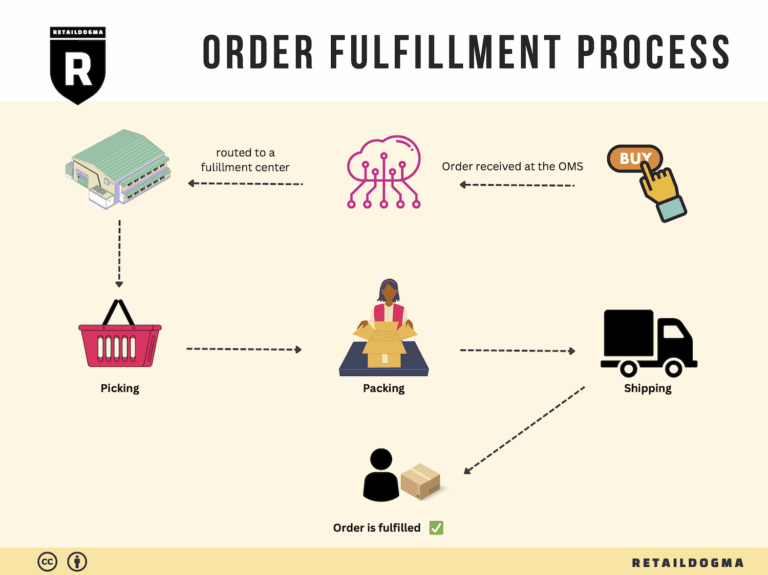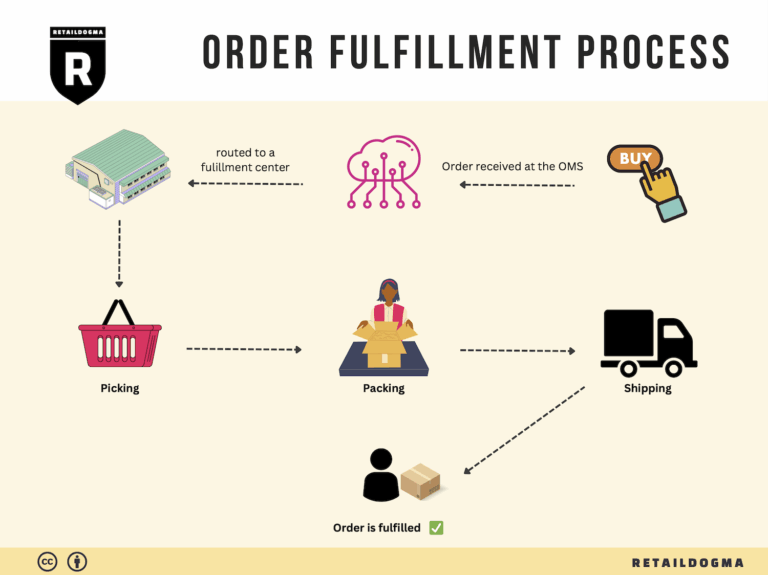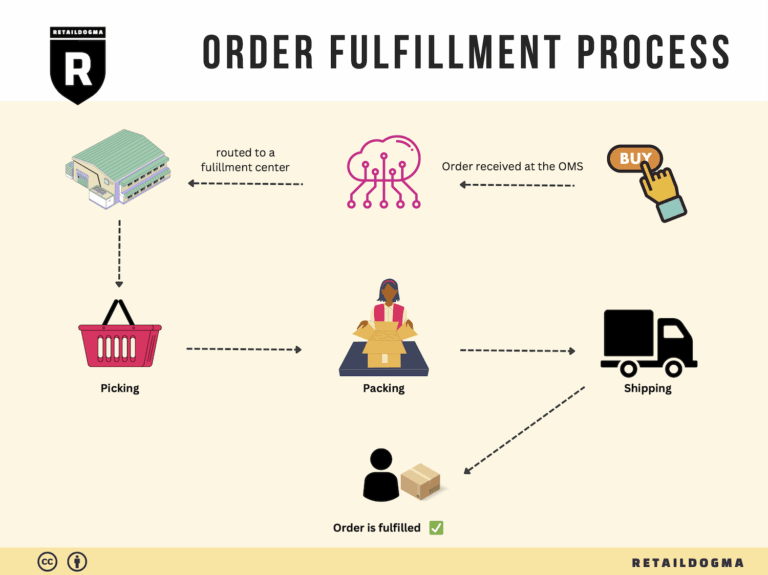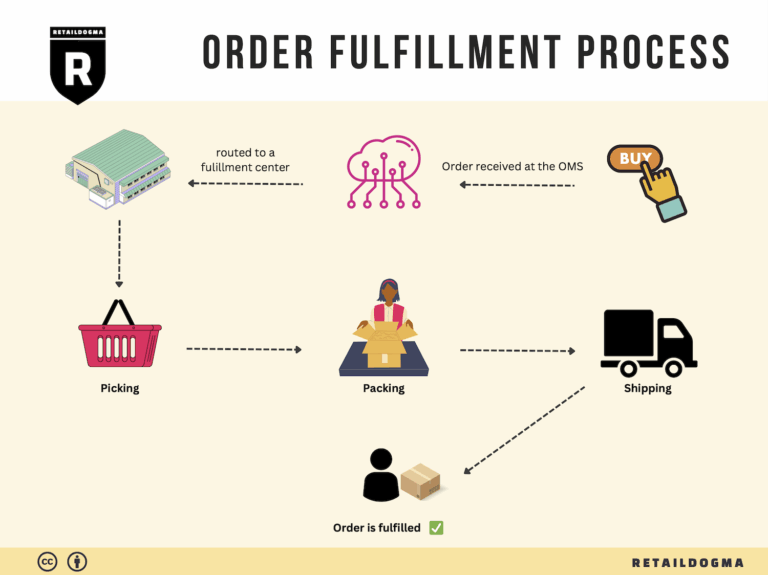Ecommerce Fulfillment Services: The Ultimate Guide (2025)
What is E-commerce Fulfillment? An Introduction for Growing Businesses
Understanding E-commerce Fulfillment
As a growing e-commerce business owner, you may find yourself increasingly overwhelmed by the demands of packing and shipping orders. The excitement of expanding your product line and reaching new customers can quickly turn into stress when faced with the complexities of logistics. This is where e-commerce fulfillment comes into play—essentially, it’s the process of getting your products from your warehouse or store directly to your customers’ doorsteps.
E-commerce fulfillment is a critical component of your business operations, encompassing everything from inventory management and order processing to shipping and customer service. For many businesses, choosing the right fulfillment model can make a significant difference in operational efficiency and customer satisfaction. In this guide, we will delve into various fulfillment models, including Third-Party Logistics (3PL) and Fulfillment by Amazon (FBA), each offering unique advantages and challenges.
What This Guide Covers
This guide will provide a comprehensive overview of e-commerce fulfillment, addressing key aspects that every business owner should consider:
-
Fulfillment Models: We’ll explore different fulfillment options, including 3PL and FBA, helping you understand how each model works and which might be best suited for your business needs.
-
Core Services: We’ll outline the essential services offered by fulfillment providers, such as inventory storage, order picking, packing, shipping, and returns management. Understanding these services will help you evaluate potential partners more effectively.
-
Choosing a Partner: Selecting the right fulfillment partner is crucial for your business’s success. We’ll provide practical tips on what to look for in a fulfillment provider, including technology capabilities, service levels, and flexibility.
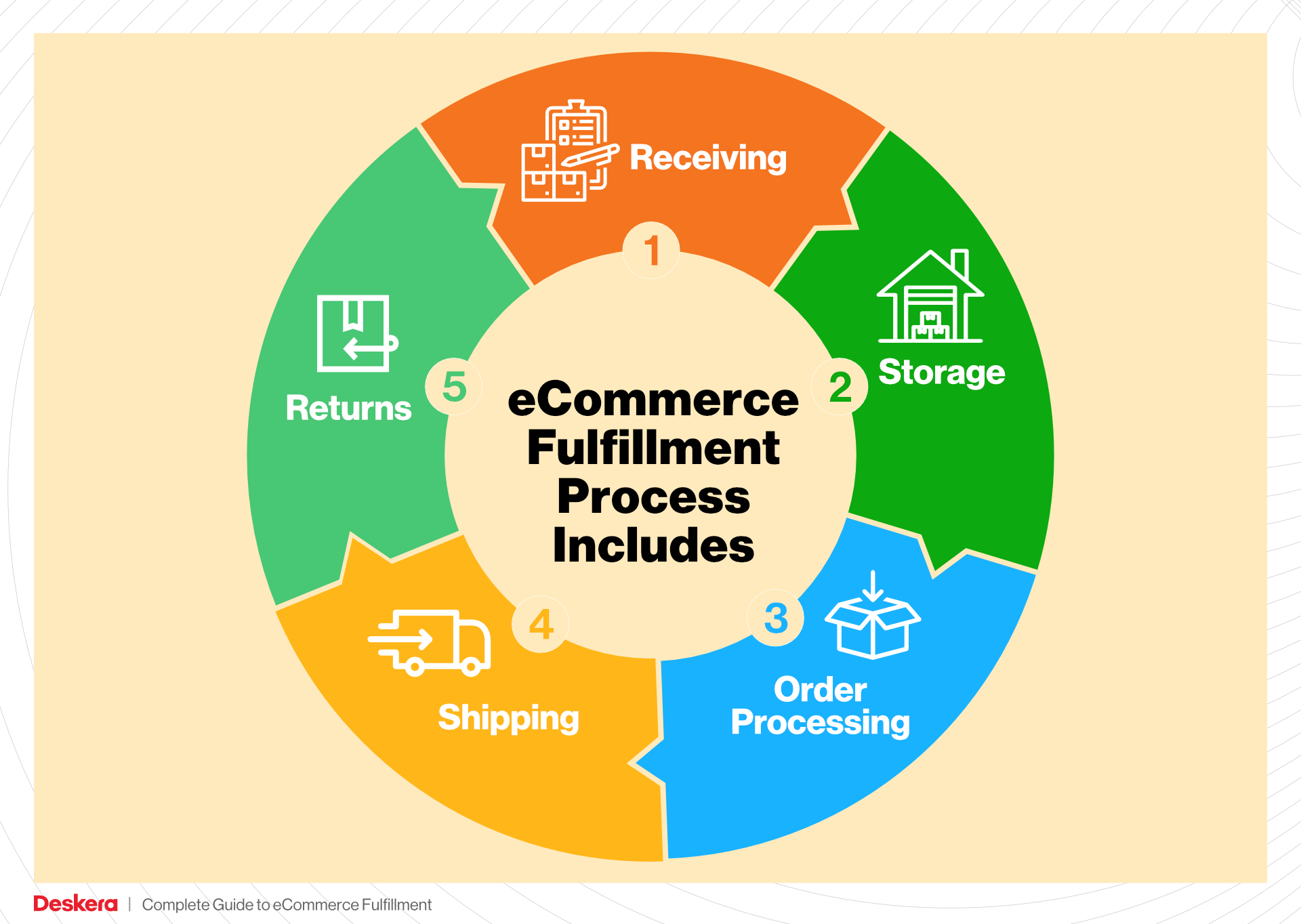
-
Pricing: Fulfillment costs can vary significantly based on the model and provider you choose. We’ll break down the typical pricing structures associated with e-commerce fulfillment to help you budget appropriately.
Empowering Smart Decisions
Ultimately, the goal of this guide is to empower you with the knowledge and insights needed to make informed decisions about your logistics strategy. By understanding the intricacies of e-commerce fulfillment, you can streamline your operations, enhance customer satisfaction, and focus on what truly matters: growing your business. Whether you’re just starting or scaling up, effective fulfillment strategies can position you for success in today’s competitive marketplace.
What You’ll Learn In This Guide
- What is E-commerce Fulfillment? An Introduction for Growing Businesses
- The Order Fulfillment Process: From ‘Buy’ Button to Customer’s Door
- Comparing Fulfillment Models: In-House vs. 3PL vs. Dropshipping
- A Deep Dive into Amazon FBA: Pros, Cons, and Who It’s For
- Core Services Offered by Fulfillment Centers
- How to Choose a Fulfillment Partner: A 6-Point Checklist
- Understanding Fulfillment Pricing: A Breakdown of Common Fees
- Frequently Asked Questions (FAQs) about Fulfillment
- Conclusion: Is Outsourcing Fulfillment the Right Move for Your Business?
- Important Disclaimer
The Order Fulfillment Process: From ‘Buy’ Button to Customer’s Door
1. Receiving Inventory
The first step in the order fulfillment process is receiving inventory at the fulfillment center. When products arrive, they undergo a thorough check for accuracy and quality. Each item is scanned and labeled with a Stock Keeping Unit (SKU), which helps in tracking inventory efficiently.
Importance: This step is crucial because it ensures that the fulfillment center has the correct products in the right quantities. Any discrepancies can lead to stockouts or overstock situations, which can severely impact customer satisfaction and operational efficiency.
Key Term: SKU (Stock Keeping Unit) – A unique identifier for each product that simplifies tracking and inventory management.
2. Warehouse Storage
Once the inventory is received and verified, it is stored within the warehouse. Items are organized based on a systematic layout that optimizes space and improves accessibility. Advanced inventory management systems are employed to track the location of each SKU within the facility.
Importance: Proper storage is vital for maintaining inventory integrity and ensuring swift retrieval during order fulfillment. An organized warehouse minimizes the time spent searching for products, thereby increasing operational efficiency.
Key Term: Inventory Management System – Software that tracks inventory levels, orders, sales, and deliveries, facilitating real-time insights into stock availability.
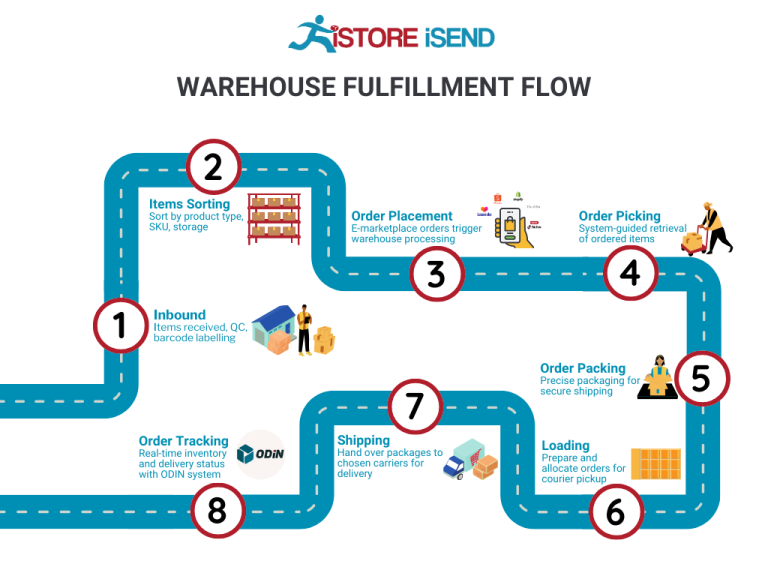
3. Order Picking
When a customer places an order, the next step is order picking. Workers utilize pick lists—documents or digital instructions that specify which items to retrieve from the warehouse. This process often involves a combination of human labor and automated systems, such as robotic pickers, to enhance efficiency.
Importance: Efficient order picking is critical for meeting customer expectations regarding delivery speed. The quicker items can be retrieved, the faster they can be processed for shipment. Errors in this stage can lead to incorrect orders being sent out, resulting in customer dissatisfaction and increased return rates.
Key Term: Pick List – A document that outlines the items and quantities needed for fulfilling a specific order, guiding workers through the picking process.
4. Order Packing
After the items are picked, they proceed to the packing station. Here, each product is carefully packaged based on its size and fragility. Packaging materials are selected to ensure that items are protected during transit while minimizing waste and costs.
Importance: Proper packing is essential to prevent damage during shipping and to maintain the quality of the product upon arrival. Additionally, effective packing strategies can reduce shipping costs and improve the overall customer experience by ensuring that items arrive in pristine condition.
Key Term: Packing Slip – A document included in the package that lists the items contained within, serving as a receipt for the customer and a verification tool for the order.
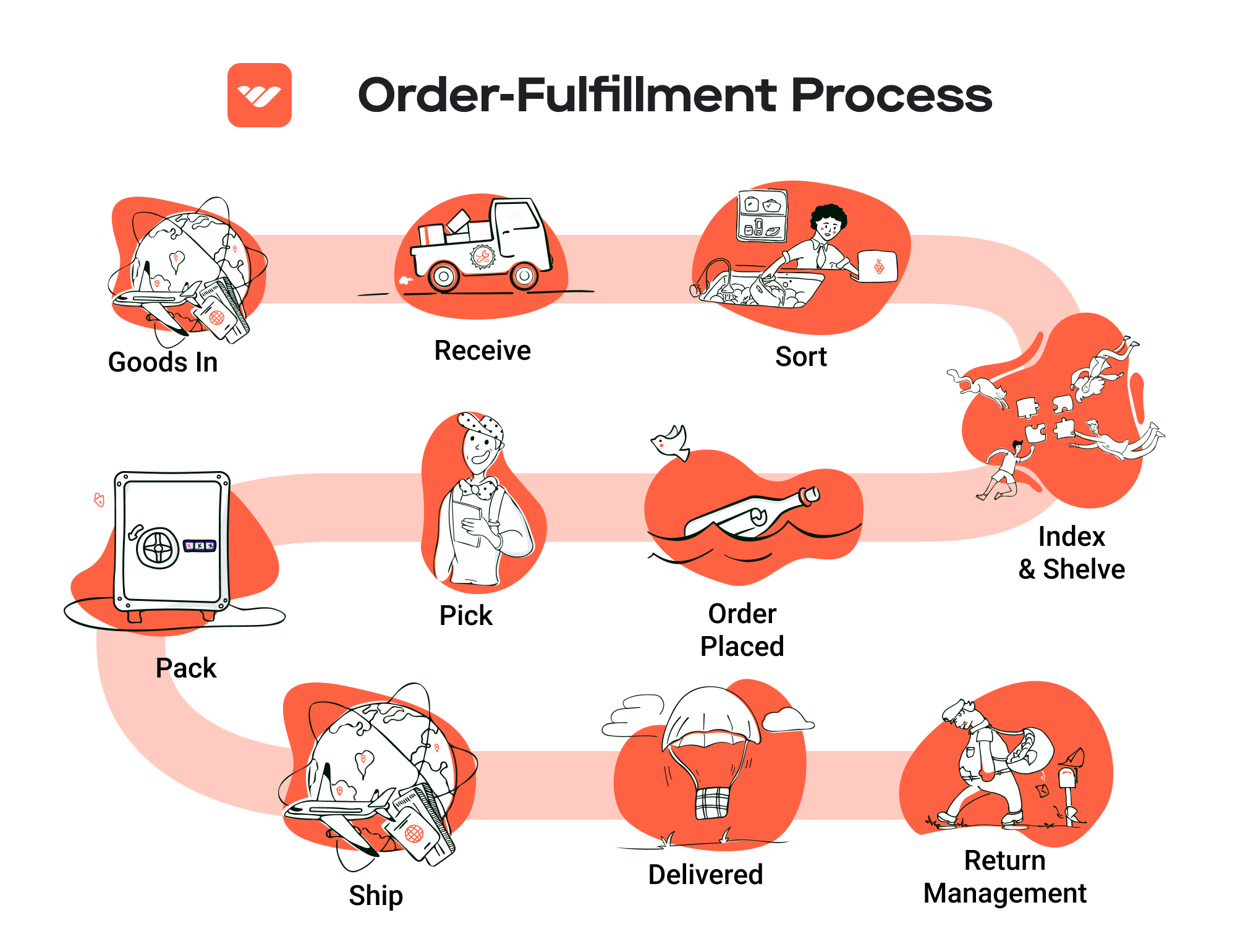
5. Shipping & Delivery
The final step in the order fulfillment process is shipping and delivery. Once the order is packed, it is labeled and sorted based on the shipping destination and delivery method chosen by the customer. Fulfillment centers leverage a variety of shipping carriers to ensure timely delivery.
Importance: Efficient shipping is crucial for maintaining customer satisfaction. Fast and reliable delivery options can set a business apart from competitors and enhance customer loyalty. Tracking information is usually provided to customers, allowing them to monitor their order’s journey.
Key Term: Shipping Carrier – A company that transports goods from the fulfillment center to the customer, which can include major players like UPS, FedEx, or USPS.
By understanding each step in the order fulfillment process, e-commerce businesses can streamline their operations, reduce costs, and enhance customer satisfaction. Investing in the right systems and practices at each stage ensures that products move smoothly from the ‘buy’ button to the customer’s door.
Comparing Fulfillment Models: In-House vs. 3PL vs. Dropshipping
Fulfillment Model Comparison Table
| Model | Who Handles Inventory | Best For (Business Stage) | Key Advantage | Key Disadvantage |
|---|---|---|---|---|
| In-House Fulfillment | The business itself | Startups and small businesses | Complete control over inventory | High overhead costs and labor needs |
| Third-Party Logistics (3PL) | A third-party provider | Growing businesses and established brands | Scalability and operational efficiency | Less control over inventory management |
| Dropshipping | Supplier or manufacturer | New businesses with limited capital | Low upfront investment | Lower profit margins and inventory risk |
In-House Fulfillment
In-house fulfillment refers to the process where a business manages its own storage, inventory, packing, and shipping operations. This model is often adopted by startups and small businesses that want to maintain control over every aspect of their logistics. Businesses opting for in-house fulfillment benefit from having direct oversight of their inventory, allowing for personalized packing and shipping experiences that can enhance customer satisfaction. Additionally, it enables businesses to quickly adapt to changes in demand or product offerings without relying on external partners. However, this model comes with significant challenges, including high overhead costs associated with warehousing, staffing, and equipment. As businesses grow, they may struggle to keep up with order volume, leading to potential delays and errors in fulfillment. Therefore, while in-house fulfillment provides control and customization, it may not be sustainable for scaling operations.
Third-Party Logistics (3PL)
Third-party logistics (3PL) involves outsourcing warehousing and fulfillment operations to a specialized provider. This model is particularly beneficial for growing businesses and established brands that seek to scale their logistics without the burden of managing inventory themselves. 3PL providers typically offer a range of services, including storage, order processing, packing, and shipping, allowing businesses to focus on their core competencies such as marketing and product development. The key advantage of using 3PL is scalability; as demand increases, businesses can easily adjust their logistics needs without significant upfront investment in infrastructure. However, a potential downside is the loss of control over inventory management and fulfillment processes. Businesses must establish clear communication and trust with their 3PL partner to ensure seamless operations. Moreover, while 3PL can provide cost savings in the long run, upfront fees and service charges may initially be a consideration for businesses.
Dropshipping
Dropshipping is a fulfillment model where a business sells products it does not physically keep in stock. Instead, when a customer places an order, the business purchases the item from a third-party supplier, who then ships it directly to the customer. This model is particularly attractive for new businesses with limited capital, as it requires minimal upfront investment in inventory. Entrepreneurs can test various products without the financial risk associated with unsold stock. The primary advantage of dropshipping is its low barrier to entry, allowing for rapid market testing and flexibility in product offerings. However, dropshipping comes with its own set of challenges. Profit margins are typically lower, as businesses must pay wholesale prices to suppliers while selling at retail prices. Additionally, reliance on suppliers for inventory management can lead to issues with stock availability and fulfillment speed, potentially harming customer satisfaction. Businesses must also navigate the complexities of returns and customer service, which can be more challenging when not directly handling products.
In conclusion, choosing the right fulfillment model is crucial for e-commerce businesses looking to scale effectively. Each model—whether in-house fulfillment, third-party logistics, or dropshipping—offers unique advantages and disadvantages that should be carefully evaluated against the specific needs and goals of the business. By understanding these models, entrepreneurs can make informed decisions that align with their operational capabilities and growth aspirations.
A Deep Dive into Amazon FBA: Pros, Cons, and Who It’s For
Understanding Fulfillment by Amazon (FBA)
Fulfillment by Amazon (FBA) is a service offered by Amazon that enables sellers to leverage Amazon’s extensive logistics network to store, package, and ship their products. By utilizing FBA, sellers can send their inventory to Amazon’s fulfillment centers, where Amazon takes care of the entire order fulfillment process, including storage, picking, packing, and shipping directly to customers. This service is especially appealing to e-commerce business owners looking to scale their operations without the overhead of managing logistics themselves.
How FBA Works
-
Inventory Preparation: Sellers must prepare their products according to Amazon’s specific guidelines, including labeling and packaging. Ensuring compliance with these requirements is crucial for smooth processing at the fulfillment centers.
-
Shipping to Fulfillment Centers: Once the products are prepared, sellers create a shipping plan in Amazon Seller Central and send their products to designated fulfillment centers. Amazon has over 110 fulfillment centers in the U.S. alone, strategically located to facilitate quick shipping.
-
Storage and Management: Upon arrival, products are checked, counted, and stored in the fulfillment centers. Amazon uses advanced inventory management systems to track stock levels and product availability.
-
Order Fulfillment: When a customer places an order, Amazon takes over. They pick the product from storage, pack it, and ship it directly to the customer. This process is streamlined through a mix of human labor and robotics, ensuring efficiency and accuracy.
-
Customer Service and Returns: FBA also includes customer service management. Amazon handles inquiries, returns, and other customer-related issues on behalf of the seller, further alleviating operational burdens.
Pros of Using FBA
-
Prime Eligibility: One of the most significant advantages of FBA is that it qualifies products for Amazon Prime. This status can lead to increased visibility and sales, as Prime members are often more likely to purchase items that offer free two-day shipping.
-
Enhanced Customer Trust: Products fulfilled by Amazon are often perceived as more reliable due to Amazon’s strong brand reputation. This trust can lead to higher conversion rates and customer loyalty.
-
Multi-Channel Fulfillment: FBA allows sellers to use Amazon’s logistics for orders placed outside of the Amazon marketplace. This multi-channel fulfillment capability means that sellers can manage orders from their own websites or other platforms while still benefiting from Amazon’s efficient shipping and handling processes.
-
Outsourced Logistics: By outsourcing the logistics to Amazon, sellers can focus on other crucial aspects of their business, such as product development, marketing, and customer engagement.
Cons of Using FBA
-
High Fees: FBA comes with various fees, including storage fees, fulfillment fees, and additional charges for long-term storage. For sellers with tight margins, these costs can significantly impact profitability.
-
Strict Inventory Rules: Amazon has stringent policies regarding inventory management. Sellers must adhere to guidelines about product preparation, labeling, and storage. Failure to comply can result in additional charges or penalties.
-
Commingling Risks: FBA operates on a commingling basis, meaning that products from different sellers may be stored together. This can lead to issues if a customer receives a product that is not from the original seller, potentially damaging brand reputation and complicating returns.
-
Limited Control Over Shipping: While Amazon’s logistics are efficient, sellers have limited control over the shipping process, including packaging and shipping times. This can lead to situations where products are shipped in a way that doesn’t align with a seller’s brand image.
Who is FBA Best For?
FBA is best suited for e-commerce businesses that are looking to scale quickly without the complexities of managing logistics. It is particularly advantageous for:
-
Small to Medium-Sized Businesses: These businesses may not have the resources to manage their own warehousing and logistics. FBA provides a robust solution that allows them to focus on sales and marketing.
-
Sellers with High Sales Volume: Businesses that expect to sell a large volume of products can benefit from FBA’s efficiencies and Prime eligibility, which can drive more sales.
-
Entrepreneurs Entering New Markets: For sellers looking to expand their reach, FBA can facilitate entry into new markets with Amazon’s established customer base and logistics network.
-
Multi-Channel Retailers: Businesses selling on multiple platforms can streamline operations by using FBA for all their fulfillment needs, regardless of where the sale occurs.
In conclusion, Fulfillment by Amazon offers a powerful tool for e-commerce businesses aiming to enhance their operational efficiency and customer service. While there are costs and risks involved, the benefits of increased visibility, customer trust, and logistical support make it an attractive option for many sellers. As with any business decision, it’s essential to weigh the pros and cons carefully to determine if FBA aligns with your operational goals and business model.
Core Services Offered by Fulfillment Centers
Inventory Management & Warehousing
Inventory management and warehousing form the backbone of fulfillment center operations. These centers provide a dedicated space for e-commerce businesses to store their products securely. Upon arrival, products are checked, counted, and organized, ensuring that inventory levels are accurate and readily accessible.
Benefits:
1. Real-Time Tracking: Fulfillment centers utilize advanced inventory management systems that offer real-time tracking of stock levels. This allows businesses to maintain optimal inventory levels and avoid stockouts or overstock situations, which can lead to lost sales or increased holding costs.
-
Space Efficiency: By outsourcing warehousing to a fulfillment center, e-commerce businesses can save on the costs associated with leasing or maintaining their own storage facilities. This is particularly advantageous for small to mid-sized businesses that may not have the capital to invest in large warehouse spaces.
-
Scalability: As a business grows, so too does its inventory. Fulfillment centers provide scalable solutions, allowing businesses to increase or decrease their storage needs based on demand without the hassle of relocating or expanding their own facilities.
Pick and Pack Services
Pick and pack services are critical for ensuring that orders are fulfilled accurately and efficiently. When a customer places an order, fulfillment center staff locate the items in the warehouse, pick them from the shelves, and package them for shipment. This process is often enhanced by technology, including handheld devices and automated systems that streamline operations.
Benefits:
1. Speed and Accuracy: Fulfillment centers are designed to process orders quickly. The use of technology minimizes human error, ensuring that the right items are picked and packed, which enhances customer satisfaction and reduces return rates.
-
Cost-Effective Operations: By outsourcing pick and pack services, businesses can avoid the labor costs associated with hiring, training, and managing in-house staff. Fulfillment centers typically have established processes that allow for faster order processing, translating to lower operational costs.
-
Focus on Core Business: With fulfillment handled by experts, e-commerce businesses can concentrate on their core activities, such as marketing, product development, and customer engagement, rather than getting bogged down in logistics.
Kitting and Assembly
Kitting and assembly services involve grouping individual items together to create a single product or kit. This is particularly beneficial for businesses that sell products that are often bundled together, such as gift sets, subscription boxes, or promotional packages. Fulfillment centers can manage the assembly of these kits prior to shipping, ensuring that everything is organized and ready for delivery.
Benefits:
1. Enhanced Customer Experience: Kitting allows businesses to offer customized solutions that cater to customer preferences. By providing ready-to-ship bundles, businesses can improve the shopping experience, leading to higher customer satisfaction and repeat purchases.
-
Efficient Use of Resources: Outsourcing kitting to fulfillment centers frees up valuable time and resources for businesses. Instead of managing assembly in-house, companies can rely on fulfillment experts to handle the process efficiently, which can be particularly beneficial during peak sales periods.
-
Streamlined Inventory Management: By managing kitting in the fulfillment center, businesses can simplify their inventory management. Instead of tracking individual items, they can track finished kits, reducing complexity and improving accuracy in stock management.
Returns Management (Reverse Logistics)
Returns management, often referred to as reverse logistics, is a crucial service provided by fulfillment centers. This process involves handling customer returns, inspecting returned items, and determining the appropriate next steps—whether restocking, refurbishing, or disposing of the products.
Benefits:
1. Improved Customer Trust: Efficient returns management is essential for maintaining customer trust and satisfaction. By handling returns professionally, fulfillment centers can help businesses foster positive relationships with customers, encouraging future purchases.
-
Cost Reduction: Returns can be costly if not managed properly. Fulfillment centers employ systems that minimize the costs associated with returns, including efficient inspection and restocking processes. This can significantly reduce the financial impact of returns on a business.
-
Data Insights: Returns management provides valuable insights into customer preferences and product issues. Fulfillment centers can analyze return data to identify trends, enabling businesses to make informed decisions about product quality, marketing strategies, and inventory management.
In conclusion, partnering with a fulfillment center offers a range of core services that can significantly enhance the efficiency and scalability of e-commerce operations. From inventory management to returns processing, these services allow businesses to streamline their logistics, reduce costs, and ultimately improve customer satisfaction. By leveraging the expertise of fulfillment centers, e-commerce businesses can focus on growth and innovation, ensuring their long-term success in a competitive marketplace.
How to Choose a Fulfillment Partner: A 6-Point Checklist
Location & Warehouse Network
Importance: The geographical location of your fulfillment partner’s warehouses can significantly impact shipping times, costs, and overall customer satisfaction. A partner with strategically placed warehouses can help you reach a larger customer base more efficiently.
Questions to Ask:
– How many fulfillment centers do you operate, and where are they located?
– Can you provide insights into your shipping times to major markets?
– How do you handle shipping during peak seasons, such as holidays?
Technology & Integrations
Importance: Modern fulfillment operations rely heavily on technology for inventory management, order processing, and tracking. A partner with robust technology and seamless integrations can streamline your operations and improve accuracy.
Questions to Ask:
– What technology platform do you use for inventory and order management?
– Do you offer integrations with popular e-commerce platforms (e.g., Shopify, Amazon, WooCommerce)?
– How do you handle data security and privacy?
Specializations (e.g., cold storage, oversized items)
Importance: Depending on your product line, you may require specialized services such as cold storage for perishables or handling oversized items. A partner with the right specializations can ensure your products are stored and shipped under optimal conditions.
Questions to Ask:
– Do you have experience handling products similar to mine?
– What specialized services do you offer (e.g., cold storage, packaging for fragile items)?
– How do you ensure compliance with industry regulations for specialized goods?
Scalability & Capacity
Importance: As your business grows, your fulfillment needs will evolve. Choosing a partner that can scale with you is crucial for long-term success. A partner with ample capacity can accommodate your growth without compromising service levels.
Questions to Ask:
– What is your current capacity, and how do you plan to scale in the next few years?
– How do you manage fluctuations in order volume, especially during peak seasons?
– Can you provide case studies of how you’ve scaled operations for other clients?
Pricing and Contracts
Importance: Understanding the pricing structure and contract terms is essential to avoid unexpected costs. A transparent pricing model will help you budget effectively and assess the overall value of the partnership.
Questions to Ask:
– Can you provide a detailed breakdown of your pricing structure (e.g., storage fees, pick-and-pack fees, shipping costs)?
– Are there any additional fees I should be aware of (e.g., for returns, seasonal surcharges)?
– What are the terms of your contract, and is there flexibility for renegotiation as my business evolves?
Customer Support & Reviews
Importance: Reliable customer support can make a significant difference in your fulfillment operations. A partner that values communication and customer service can help resolve issues quickly, minimizing disruptions to your business.
Questions to Ask:
– What level of customer support do you offer (e.g., dedicated account manager, 24/7 support)?
– Can you provide references or case studies from current or past clients?
– How do you handle disputes or issues that arise during the fulfillment process?
Conclusion
Choosing the right fulfillment partner is a critical decision that can influence your e-commerce business’s efficiency and growth potential. By systematically evaluating potential partners using this checklist, you can make a more informed choice that aligns with your business objectives. Prioritizing factors such as location, technology, specialization, scalability, pricing, and customer support will ensure that your fulfillment operations are robust and capable of meeting your customers’ expectations.
Understanding Fulfillment Pricing: A Breakdown of Common Fees
Initial Setup Fees
Initial setup fees are often the first cost incurred when a business begins using a fulfillment center, particularly for services like Fulfillment by Amazon (FBA). These fees cover the administrative and logistical efforts needed to onboard a new seller.
Typically, initial setup fees may include costs associated with account creation, integration of inventory management systems, and initial training for using the fulfillment center’s platform. While some fulfillment centers may waive these fees as an incentive for new sellers, others may charge a flat fee ranging from $50 to several hundred dollars. It’s essential to inquire about these costs upfront to avoid surprises as you start your partnership.
Receiving Fees
Receiving fees are charged when products arrive at the fulfillment center. These fees cover the costs of unloading, checking, and storing inventory.
Calculating receiving fees generally depends on the number of units being received and the complexity of the receiving process. For instance, a fulfillment center may charge a per-unit fee (e.g., $0.20 to $0.50 per item), which can vary based on the size and weight of the products. Some centers may also impose additional fees for items that require special handling or inspection.
To optimize costs, sellers should ensure that shipments are well-organized and comply with the fulfillment center’s receiving requirements.
Storage Fees (per pallet/bin)
Storage fees are charged for keeping inventory at the fulfillment center and are typically calculated on a monthly basis. These fees can be based on the amount of space your products occupy, measured in pallets or bins.
Common pricing structures include:
– Per Pallet Fee: This fee is usually assessed monthly and can range from $15 to $30 per pallet, depending on the fulfillment center’s location and the overall demand for storage space.
– Per Bin Fee: If a fulfillment center uses bin shelving, fees may be calculated per bin, which could be around $5 to $10 monthly.
It’s crucial for businesses to monitor their inventory levels, as excess stock can lead to increased storage fees. To minimize costs, sellers should implement an efficient inventory management system to ensure that only the necessary stock is stored.
Pick & Pack Fees (per item/order)
Pick and pack fees are incurred each time a product is picked from storage, packed for shipping, and prepared for delivery to the customer. These fees can vary significantly based on the fulfillment center’s pricing model.
Typically, pick and pack fees are calculated per item or order:
– Per Item Fee: This fee can range from $1 to $3 per item, depending on the complexity of the packing process and the size of the item.
– Per Order Fee: Some fulfillment centers may charge a flat fee per order, which can be beneficial for businesses with a high volume of smaller items.
To manage these costs effectively, businesses should consider consolidating orders when possible and optimizing packaging to reduce the number of items handled.
Shipping Fees
Shipping fees are one of the most significant costs associated with fulfillment services and are based on the weight, dimensions, and destination of the packages being sent.
There are several components to consider when calculating shipping fees:
– Weight-Based Fees: Most fulfillment centers charge based on the weight of the package, with costs escalating for heavier items. Rates can vary from carrier to carrier, so it’s important to compare options.
– Dimensional Weight Charges: Some carriers also apply dimensional weight pricing, which considers the size of the package in relation to its weight. If a package is large but light, it may incur higher shipping fees.
– Destination Fees: Shipping to remote or rural areas may incur additional charges.
To mitigate shipping costs, sellers should evaluate their shipping options regularly and consider using fulfillment centers that have negotiated favorable rates with carriers.
Tips for Getting an Accurate Quote
When seeking to understand fulfillment pricing, obtaining an accurate quote is essential for budgeting and planning. Here are several tips to ensure you receive a comprehensive and precise estimate:
-
Provide Detailed Information: When requesting a quote, include specific details about your products, including size, weight, and expected order volume. The more information you provide, the more accurate the quote will be.
-
Ask About All Fees: Ensure you inquire about all potential fees—initial setup, receiving, storage, pick & pack, and shipping—to avoid unexpected costs later.
-
Negotiate Rates: Don’t hesitate to negotiate rates, especially if you anticipate high volumes. Many fulfillment centers are willing to offer discounts based on order size and frequency.
-
Review Contracts Carefully: Before signing any agreements, review the terms and conditions thoroughly to understand the fee structure and any potential hidden costs.
-
Consider Future Scalability: When evaluating quotes, consider how the fulfillment center’s pricing will scale with your business growth. Look for flexible options that can accommodate increased demand without exorbitant costs.
By taking these steps, e-commerce business owners can better navigate fulfillment pricing and select a solution that aligns with their operational needs and budget.
Frequently Asked Questions (FAQs) about Fulfillment
1. What is an Amazon fulfillment center?
An Amazon fulfillment center is a large warehouse operated by Amazon where third-party sellers can store their products. When a customer places an order, Amazon handles the entire process of picking, packing, and shipping the product directly to the customer, allowing sellers to leverage Amazon’s extensive logistics network.
2. How does an Amazon fulfillment center work?
Amazon fulfillment centers receive inventory from sellers, store it, and manage it using advanced inventory management systems. When an order is placed, the center picks the product, packs it securely, and ships it to the customer. Amazon also manages customer service and returns for these orders.
3. What’s the difference between a warehouse and a fulfillment center?
While both warehouses and fulfillment centers store products, their purposes differ. A warehouse primarily focuses on storing goods for long-term inventory management, whereas a fulfillment center specializes in processing customer orders quickly and efficiently, handling shipping, packing, and returns.
4. What is Fulfillment by Amazon (FBA)?
Fulfillment by Amazon (FBA) is a service that allows sellers to send their products to Amazon’s fulfillment centers. Amazon then takes care of storage, order fulfillment, customer service, and returns, enabling sellers to reach a broader audience with less operational burden.
5. How much do fulfillment services cost?
Fulfillment costs vary based on several factors, including product size, weight, and category. Typically, sellers incur fees for storage, picking, packing, shipping, and returns. It’s essential to review Amazon’s fee structure for FBA to understand the potential costs associated with using their fulfillment services.
6. What is a Third-Party Logistics (3PL) provider?
A Third-Party Logistics (3PL) provider is a company that offers outsourced logistics services, including warehousing, fulfillment, and shipping. Unlike Amazon’s fulfillment centers, which are specific to Amazon sellers, 3PLs serve a broader range of clients and can tailor their services to meet unique business needs.
7. How many Amazon fulfillment centers are there?
As of 2023, Amazon operates over 110 fulfillment centers in the United States and more than 185 globally. The locations are strategically distributed to ensure fast shipping times to customers, with the highest concentrations in states like California, Texas, Illinois, Florida, and Pennsylvania.
8. How can I find the closest Amazon fulfillment center?
To locate the nearest Amazon fulfillment center, you can check the tracking information of your orders, search online for lists of fulfillment centers, or look for local news reports about new facilities. Additionally, the order details of your Amazon purchases may indicate the fulfillment center’s location.
9. What types of products can be stored in an Amazon fulfillment center?
Amazon fulfillment centers can store a wide range of products, but there are restrictions on certain items. Generally, products must comply with Amazon’s guidelines regarding size, weight, and safety. Some products, such as hazardous materials or perishables, may not be eligible for storage in their fulfillment centers.
10. How do I ship my products to an Amazon fulfillment center?
To ship products to an Amazon fulfillment center, sellers must first prepare their items according to Amazon’s requirements regarding packaging and labeling. Next, create a shipping plan in Amazon Seller Central that outlines the products being sent. Finally, arrange for transportation to the designated fulfillment center, ensuring compliance with Amazon’s shipping guidelines.
Conclusion: Is Outsourcing Fulfillment the Right Move for Your Business?
Evaluating the Benefits of Outsourcing Fulfillment
Outsourcing fulfillment can be a game-changer for e-commerce businesses looking to scale efficiently and effectively. By leveraging the capabilities of a fulfillment service, you can save significant time, allowing you to focus on critical aspects of your business, such as product development, marketing, and customer engagement. This time-saving benefit is particularly crucial for entrepreneurs and operations managers who often juggle multiple responsibilities.
Moreover, fulfillment services provide scalability that can adapt to your business growth. As your sales volume increases, fulfillment centers can handle larger inventories and more complex logistics without the need for substantial upfront investments in warehousing and staffing. This flexibility allows you to respond quickly to market demands and seasonal spikes, ensuring that you remain competitive.
In addition, partnering with a fulfillment service grants you access to their expertise and established logistics networks. These providers often have advanced technology and processes in place that can enhance order accuracy and speed, leading to improved customer satisfaction. Furthermore, they manage the intricacies of shipping, returns, and customer service, which can otherwise consume valuable resources.
However, it’s essential to choose the right fulfillment partner to align with your growth objectives. The ideal partner should not only meet your logistical needs but also share your commitment to customer service and quality. Conducting a thorough audit of your current shipping processes can help you identify gaps and determine if a fulfillment service is the right next step for your business.
Call to Action
Take the time to evaluate your current fulfillment operations. Assess whether the time, resources, and expertise you could gain from outsourcing fulfillment can propel your business forward. If you find that handling logistics internally is hindering your growth, it may be time to explore fulfillment partnerships that can support your ambitions and streamline your operations.
Important Disclaimer
⚠️ Important Disclaimer
The information in this guide is for educational purposes. Fulfillment services, pricing, and platform features change frequently. Always conduct your own due diligence and consult with providers directly before making business decisions.
